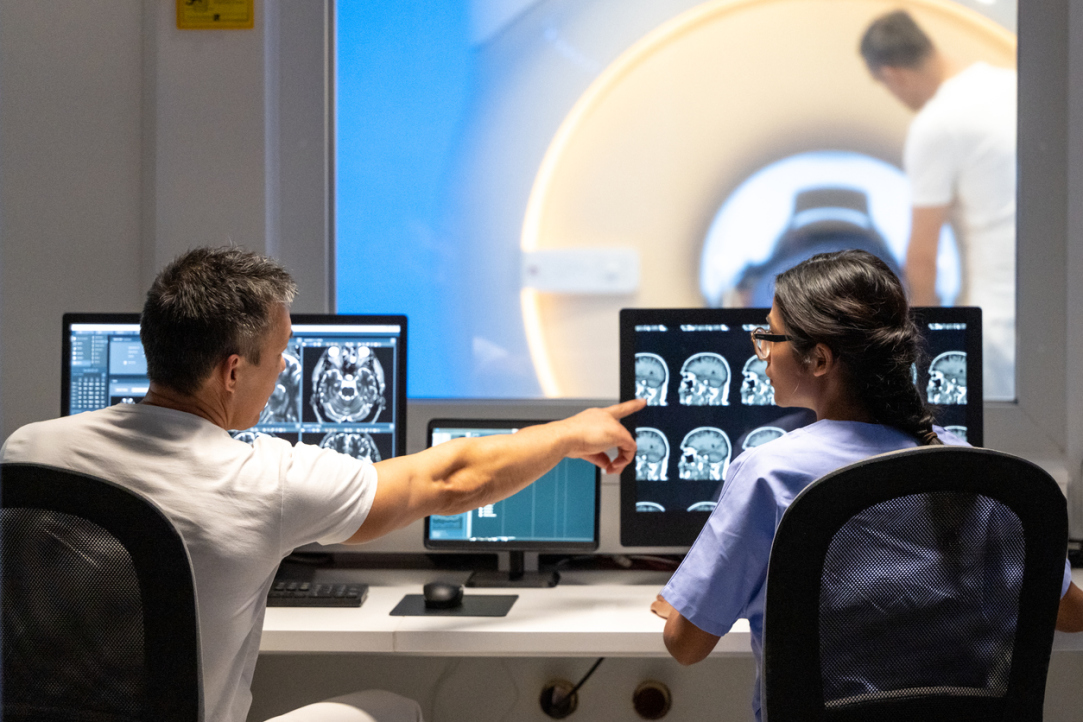Researchers Have Developed a Russian-Language Method for the Preoperative Mapping of Language Areas

Neurolinguists from HSE University, in collaboration with radiologists from the Pirogov National Medical and Surgical Centre, developed a Russian-language protocol for functional magnetic resonance imaging (fMRI) that makes it possible to map individual language areas before neurosurgical operations. The study was published in Frontiers in Human Neuroscience.
When neurosurgeons operate on brain tumors, their goal is to remove the pathological tissue while preserving the adjacent areas critical to various motor and cognitive functions, including language, as much as possible. The ability to preserve the language areas determines whether the patient will have language disorders after the operation and be able to easily communicate with others, hold a job and lead an ordinary life.
The exact location of language areas differs from one person to the next, so special methods must be used to map them in each patient. The most accurate method is direct electrical stimulation during a neurosurgical operation. But sometimes the neurosurgeon needs to know beforehand where a particular patient’s language areas are located to make the best possible plan for the operation. Such preoperative mapping is performed using functional MRI, or fMRI. While situated in an MRI scanner, the patient performs language-related tasks. Data analysis shows which areas in the brain are activated.
Until now, most protocols for preoperative language mapping by this method were developed in English. Scientists from HSE University have developed the first Russian-language fMRI protocol that uses a language task recommended by the international scientific community—sentence completion.
The patient must read aloud a sentence that is missing the last word (such as ‘The audience watched a long …’) and then finish the sentence with an appropriate word (such as ‘play’ or ‘movie’). This task is unique in that it involves both language production and comprehension at the sentence level, making it possible to comprehensively map the patient’s language areas.
Researchers validated the protocol in a control group of 18 healthy Russian-speaking volunteers aged 30-53. This proved that the protocol successfully maps the most important language areas in the frontal and temporal lobes of the brain and reveals the individual lateralisation of the language function—that is, the degree to which this function relies on the left and right hemispheres of the brain. The researchers also demonstrated the high reliability of the protocol: each volunteer underwent the procedure twice with an interval of several weeks and the results were similar. This is the first Russian-language protocol that has undergone such extensive validation.

Svetlana Malyutina, researcher at the HSE Centre for Language and Brain and a co-author of the article
'The first stage of the study has been completed, showing the validity and reliability of the protocol in the control group. We are now doing the most important part—testing the protocol in clinical practice, using it for preoperative speech mapping in patients with brain tumors and epilepsy. We plan to analyse whether the protocol works as well in clinical groups as it does in the control group. We will test how well its results match those of intraoperative mapping and, therefore, how widely it should be applied in clinical practice.'
See also:
Software for Rapid Detection of Dyslexia Developed in Russia
HSE scientists have developed a software tool for assessing the presence and degree of dyslexia in school students based on their gender, age, school grade, and eye-tracking data. The application is expected to be introduced into clinical practice in 2024. The underlying studies were conducted by specialists in machine learning and neurolinguistics at the HSE AI Research Centre.
HSE University Researchers Develop First Standardized Russian-Language Test for Aphasia-related Disorders
Researchers from the HSE University Centre for Language and Brain have created and standardized a new test battery for diagnosing language disorders in people with brain damage. The test is the first standardized assessment tool in Russia in the field. The paper entitled ‘The Russian Aphasia Test: The first comprehensive, quantitative, standardized, and computerized aphasia language battery in Russian’ has just beenpublished in the PLOS ONE journal.
Centre for Language and Brain Opens at HSE
The Centre stems from the International Neurolinguistics Laboratory and brings together researchers in clinical linguistics, special needs education, psycholinguistics, bilingualism, child speech, and gerontolinguistics. The Centre’s academic supervisor is Roelien Bastiaanse, Professor from the University of Groningen (the Netherlands), a researcher into clinical linguistics and founder of EMCL and IDEALAB, unique international educational programmes.
Center for Language and Brain Wins 3-Year Grant to Study Prevention, Diagnostics and Therapy of Language Disorders
The HSE Center for Language and Brain studies a broad range of topics related to the connection between the brain and language. For Svetlana Malyutina, Deputy Head, and Mariya Khudyakova, Junior Research Fellow, particularly interesting areas of focus include the breakdown of language processing after brain damage (e.g., stroke, neurosurgery, epilepsy) and language acquisition in children.
Unique Brain Surgeries and Electricity from Moss: HSE Scholars Present Their Discoveries at ONF Action Forum
At an exhibition held during the Russian Popular Front (ONF) Action Forum in Moscow, December 18-19, HSE neuro-linguists presented a method to preserve human speech after brain surgeries, and urbanists showcased sources of energy made of ceramics and moss.
'Surgery Needs to Preserve Brain Tumour Patients' Speech in Native Language’
As part of the HSE April Conference, Olga Dragoy, Head of HSE Center for Language and Brain (Neurolinguistics Laboratory), presented some of the cutting-edge methods of preventing speech disorders in Russian-speaking patients with brain pathology, including the first Russian-language intraoperative naming test developed by the laboratory. All test materials and instructions are available for free and can be used in clinical practice.
Fishing Easier Than Swimming
HSE researchers found different patterns of brain activity involved in processing instrumental and non-instrumental verbs.
HSE Researchers Expand on Neuroanatomical Model of Semantic Aphasia
For the last 70 years, it was largely believed that spatial processing disorders, including those seen in language, occurred when the temporal-parietal-occipital (TPO) junction of the brain’s left hemisphere was damaged. But according to researchers from the HSE Neurolinguistics Laboratory, it is the damages to the axonal fibers connected to this area of the brain that are most important.
Neurolinguistics Laboratory Informs Public about Aphasia
Staff members at the HSE Neurolinguistics Laboratory have developed an information booklet for families of people with aphasia - speech disorders caused by brain lesions.
‘Seeing’ Language through Neurolinguistics
What happens in a person’s head when they hear speech or say something themselves? How does trauma and disease impact a person’s speech capabilities, and can we really help people who have certain medical conditions? Questions like these concern the life of language in the human brain, and this is exactly what researchers in the HSE Neurolinguistics Laboratory are currently studying.


